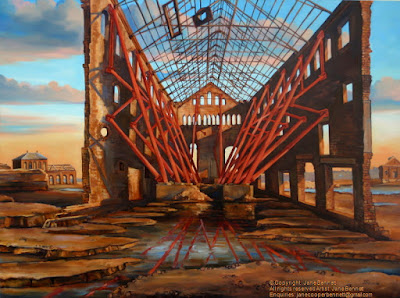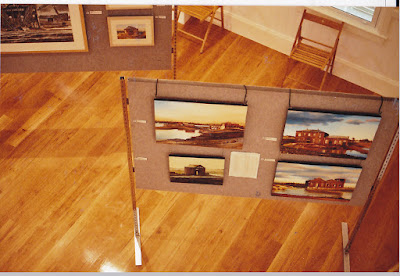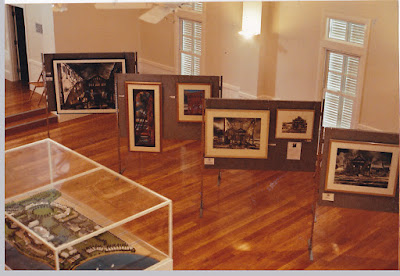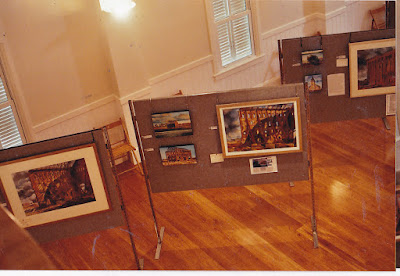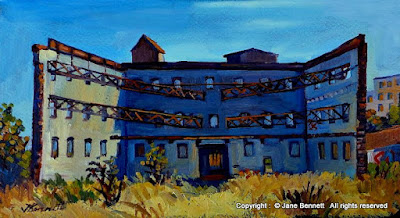Are black cats lucky?
People seem to be equally divided into those who think its lucky to have a black cat cross their path, and those who think it's very unlucky.
I feel this cat was a lucky omen for this particular nook of Pyrmont.
Union Square, in contrast to many other parts of Pyrmont, had kept much of its original character. Unlike
many other inner city neighbourhoods, this one has so far dodged the
relentless rollout of Westconnex and other highways and tollways that
has blitzed several other nearby suburbs on the fringe of the city.
In 2009, the NSW Government's proposal for a Metro entrance in the charming
historical precinct of Union Square had threatened to obliterate one of
the last remaining vestiges of Pyrmont's heritage. But times and governments change, and the whole project was cancelled in 2010. The vaguely Parisian atmosphere of Union Square remains a charming contrast to the bloated pomposity of the Star Casino only a block away. P277 Union Square Terraces + Paternoster Row
2011 oil on canvas 31 x 103cm
One of the many joys of plein air painting is that the time that I have to spend looking at my subject reveals tiny details lost to a more casual observer.
On the corner of Union st and
Paternoster Row there is a faded and clumsily drawn painting of an
almost headless black cat, which goes mostly unnoticed by the passing cyclists. It fascinates me that this cryptic little fragment has somehow escaped being scraped off or obliterated with a schmick new paint job.
It was painted by an eccentric street artist Bruno Dutot some
time between about 1989 and 1991 before the arrival of a more strident fashion in graffiti from New York a few years later.
 |
P277 Detail of cat painted on wall-
Union Square Terraces + Paternoster Row
2011 oil on canvas 31 x 103cm
Available |
This fragment of a cat once had a very soigne companion, painted in a style reminiscent of
Erte, but in an endearingly amateur fashion. She was a slender, highly
stylized and stylish woman called rather weirdly, "Oucha", and versions of this image cropped up all over the inner city in her heyday of the late 1980s - 1990s.
I remember passing her strangely elongated image on the corner of Union Square and Paternoster Row, back in the days when Union Square had two-way traffic and was a shortcut to the Fishmarkets and Glebe.
 |
P274 Union Square Terraces 4 -
a little piece of Paris in Pyrmont
2010 oil on canvas 31 x 61cm
Available
|
The painting above shows Union Square from Paternoster Row down to Pyrmont Street. It was painted in 2010, just before the cancellation of the Metro plans had been made public.
Back then, the chimneys of the Pyrmont Power Station loomed over the terraces of Union Square instead of the equally monolithic Casino. The 'Harlequin Inn' which can be seen to the right of this canvas, on the corner of Union Square and Harris Street, was then the more down at heel 'Duke of Wellington' and boasted a huge and incongruous cartwheel as a wall feature. The two way road has been transformed into a one way lane with a large pedestrian area circling the "Angel of Union Square", with seating and odd sandstone 'mushrooms' (actually part of the balustrade salvaged long ago from the now pedestrianized Pyrmont Bridge) But, essentially, very little has changed in Union Square since the 1980s.
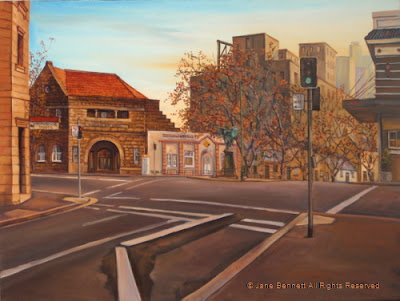 |
P242 Pyrmont Post Office
1993 oil on canvas 75 x 100cm
Available |
The painting above was painted in the early 1990s from the other end of Union Square, and shows the intersection of Union Square and Miller Street as a two-way street before it became a plaza. The "Angel of Union Square" is in the centre and behind her is the Commonwealth Bank painted a particularly horrid shade of "Paddington Pink". On the extreme right is a corner of the "Duke of Wellington" Hotel, and on the right is the golden sandstone archway of the Walter Liberty Vernon designed Pyrmont Post Office.
The last example of "Oucha" that I know of, can still be seen on a corner of Edgecliff
road on the left hand side travelling from the city towards Edgecliff. She is occasionally repainted, possibly even by the original artist, and sometimes decorated with glitter.
She and her cat are relics of a less worldly age.
The wall above the cat has an obvious tidemark where "Oucha" has been painted over with more enthusiasm than skill and it remains distinctly two-toned.
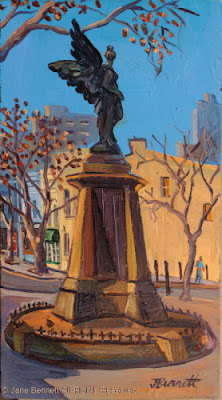
|
P276 Angel of Union Square
2010 oil on wood 23 x 12cm
Available
|
The lovely First World War monument known locally as the "Angel of Union Square" seems to have had a protective effect over her square, acting as a shield against marauding developers.
But I like to think of the little faded and forgotten black cat as her mascot.
Related Posts







